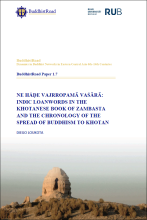BuddhistRoad Paper 1.7 "Ne Hāḍe Vajrropamä Vaśärä: Indic Loanwords in the Khotanese Book of Zambasta and the Chronology of the Spread of Buddhism to Khotan"
Synopsis
The Middle Iranian Khotanese language received copious amounts of loanwords from the Indic Gāndhārī and Sanskrit languages. These loanwords have not, however, been systematically studied, and although the present paper does not constitute an attempt to provide such a comprehensive survey, it makes a limited probe in the same direction through the examination of the borrowed vocabulary in the 5th century Book of Zambasta, the longest extant and arguably most substantial Old Khotanese text. This focused examination of the Indic element in Khotanese highlights the fact that the form of Gāndhārī that informed the earliest Khotanese spread of Buddhism was probably not identical with the one represented in the sacred Buddhist texts from Gandhāra proper, as well as distinct chronological layers, with Gāndhārī providing the majority of the vocabulary for the most basic terms for Buddhist thought and practice and Sanskrit providing, instead, the more elaborate compound repertoire of terms associated with the Mahāyāna and with mature scholastic philosophy (Skt. abhidharma).
Chinese Translation
中古伊朗语族的于阗语从印度语支的犍陀罗语和梵语中借用了大量词汇. 不过, 这些借词还没有被系统地研究过, 本文并不试图对此做全面的探讨, 但通过对5世纪《赞巴斯塔书》中借词的研究, 本文在这一议题上进行了有限的探索. 《赞巴斯塔书》是现存最长, 也可以说是最有分量的古于阗语文本。对于阗语中印度语元素的重点研究突出了这样一个事实, 即最早在于阗语中的传播佛教的犍陀罗语很可能与来自犍陀罗本土的佛教圣典中的语言形式不尽相同, 即犍陀罗语为佛教思想和实践提供了大部分最基本的词汇, 而梵文则提供了与大乘佛教和成熟的学院哲学 (梵文: abhidharma) 相关的复杂混合的术语体系; 而且这些于阗语中的印度语元素还可溯源于不同的年代.

Downloads
Published
Categories
License

This work is licensed under a Creative Commons Attribution-NonCommercial-NoDerivatives 4.0 International License.

